Kendrick Lamar and Rihanna sang “All we ask is trust—loyalty, loyalty, loyalty”.
And even though it probably wasn’t their intention, that song could be an anthem of all business owners who want to encourage customer loyalty among their clientele.
After all, businesses need customers to merely survive. And to thrive? They need to earn their loyalty.
But how to encourage customers to be loyal, and where to start? This is what we will cover in this article.
Customer loyalty definition and importance
Customer loyalty describes a customers’ willingness to return to a company in order to purchase its services or products. It is manifested when a customer makes repeat purchases, choosing a specific company over its competitors. This is usually because they developed a positive emotional relationship with the brand as a result of the delightful experiences they had with that company.
However, one of the best ways to define customer loyalty is to describe how loyal customers behave. Chip R. Bell, a veteran in customer service innovation, once said that:
Loyal customers, they don't just come back, they don't simply recommend you, they insist that their friends do business with you.

And while getting partner referrals is a perfectly good reason to increase customer loyalty, it’s not the only one. Let’s further analyze why customer loyalty is critical to your business.
The importance of customer loyalty
It’s a brutal world out there—
Currently, consumers want more than a product, they want a great experience. And when they aren’t satisfied with what you offer, they churn. As simple as that.
However, once you delight them and provide great service, they can become repeat customers—the best type of customers. And we have some of the most compelling customer loyalty statistics to prove it.
Some of the biggest benefits of customer loyalty for your business include:
- Reducing costs. Forbes reported that it could cost you up to 5x more to attract a new client than to keep an existing one. On top of that, chances of selling to a recurrent customer range between 60-70%, while chances of selling to a new customer are only 5-20%.
- Increasing revenue. Industry Insights report by the International Council of Shopping Centers states that as many as 43% of U.S. customers spend more with the brands and companies they like. This means that by increasing customer loyalty, you also increase customer lifetime value (CLV).
- Creating brand advocates. A study by Bond Brand Loyalty suggests that as many as 70% of consumers are more likely to recommend a brand if it has a good loyalty program. Therefore, investing in them will boost your word-of-mouth marketing.
Suggested read
See how referral programs can help your small e-commerce business.
Now you know—when you make efforts to keep your existing customers happy, you improve customer loyalty and drive more sales.
This naturally brings the topic of customer retention and how it influences customer loyalty. Let’s find out.
Customer loyalty and retention: what’s the difference?
Customer retention plays a big role in forming customer loyalty. After all, if the customers don’t repeat purchases, they won’t even have the chance to become loyal.
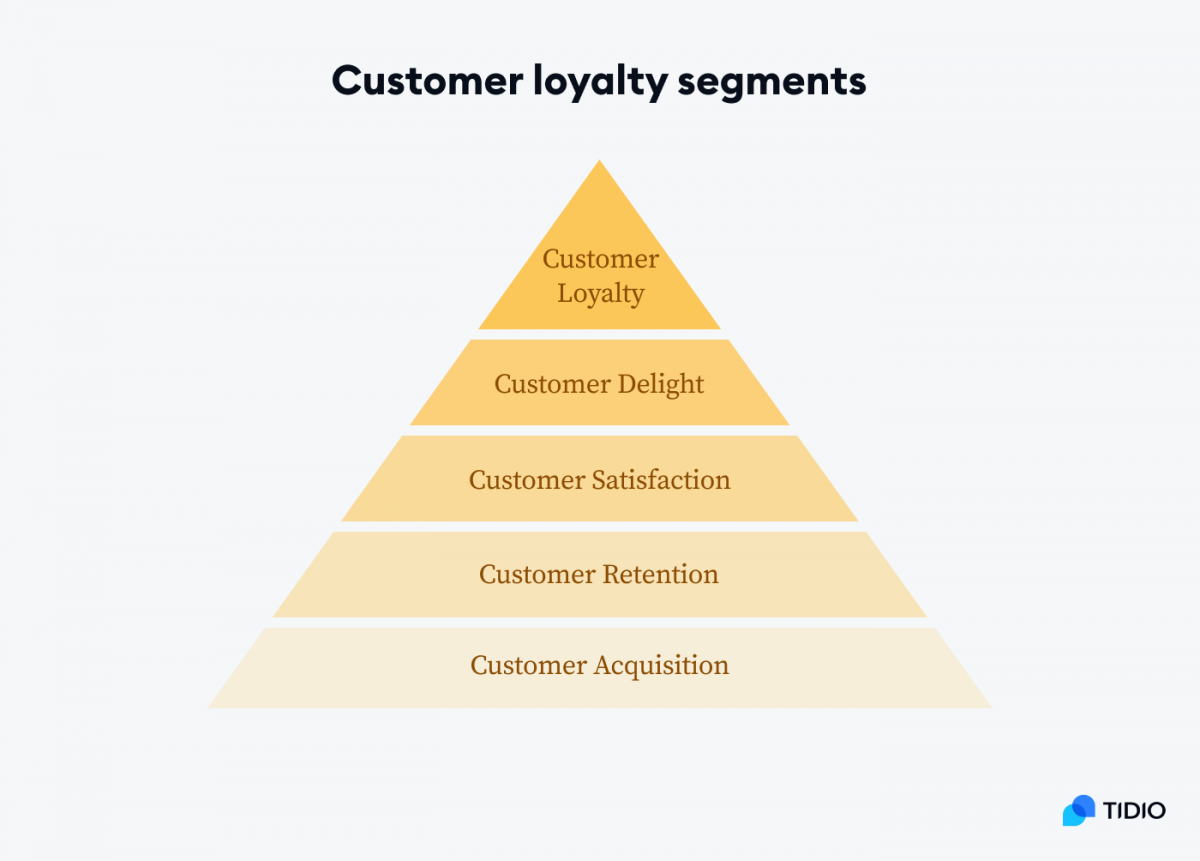
But to illustrate how these two subjects correlate, you can view your customer loyalty strategy as a pyramid:
- You start with a detailed customer acquisition plan that will enable you to form customer relationships with your clients.
- The next step is to increase customer retention rate not only to satisfy your customers but to delight them, focusing on customer success.
- Finally, you build a loyal customer base. From now on, you work on all levels to gather as many clients as possible at the top of the pyramid.
Read more: Check out the best customer retention software with pros, cons, and pricing compared. Also, be sure to check out the most effective strategies you can use to improve ecommerce customer retention.
Customer satisfaction vs customer loyalty: how to tell them apart?
“Customer satisfaction is worthless, customer loyalty is priceless” is probably one of the most popular customer loyalty quotes (and simultaneously, the title of one of the most popular books on the subject). But we wouldn’t go as far as to completely bash customer satisfaction.
We would rather say that improving customer satisfaction can help you turn your first-time customers into long-term customers.
Undoubtedly, the best way to do it is to build a positive emotional relationship with them. Happy customers don’t buy from you once. They become valuable customers who associate your brand with a first-class experience.
Now, the most important part… How do you make your customers that happy?
Building customer loyalty: how to do it right?
How to build effective customer loyalty strategies?
Your mindset should be: The competition is fierce, and loyal customers are worth their weight in gold. Your motivation? It’s vital to think outside the box to be ahead of your competitors.
Let’s have a look at a few tips that will help you build customer loyalty.
1. Focus on customer feedback
How do you know if a customer has the potential to repeat business with your company? By measuring customer feedback, you can monitor your current customers’ experience and predict business growth. Even setting up a simple NPS (Net Promoter Score) survey will allow you to assess whether you are on a good path to create customer loyalty among your clients.
Suggested read
See how you can collect customer feedback automatically with Tidio.
2. Provide great customer service
It’s a no-brainer. Microsoft’s report states that to 69% of US consumers, customer service is very important when it comes to their loyalty to a brand. After all, customer loyalty is not only about marketers promoting perks among your clientele. Providing an excellent customer experience means that your customer service teams are efficient, and your customers are delighted. Until this condition is met, your clients won’t develop a positive relationship with your brand.
Read more: Learn how to enhance your customers service efforts using a solid customer segmentation strategy.
Suggested read
Find out how to deliver excellent customer service.
3. Engage your customers with personalization and innovation
Consumers are no longer interested in traditional customer loyalty cards offering generic benefits they don’t need. As many as 85% of customers confirm that emotional connection to a brand will make them continue to do business with a company and 95% of consumers want to engage with brands through a mix of new tech, such as VR and chatbots. That’s why businesses need to focus on increasing customer engagement through new communication channels. Sending personalized “Happy Birthday” messages with discounts will definitely make you stand out.
Suggested read
See the best examples of “thank you for your order” messages.
Find out how to boost customer loyalty and recreate in-store experiences
4. Show appreciation
Nothing builds customer loyalty better than showing appreciation through special offers, discounts, and exclusive perks. By giving customer loyalty rewards, you showcase your gratitude and incentivize customers to repeat purchases.
But there is one condition—
The benefits you offer must add value. No amount of money saved thanks to a discount will improve their experience, if the product is mediocre. The reward is the cherry on the cake and consequently, your loyalty program must make a customer feel good.
Suggested read
Find out what makes your customer tick with our guide to consumer behavior.
5. Offer more than your competitors
HubSpot reports that half of US consumers will leave a brand they were loyal to for a competitor that better meets their needs. It doesn’t matter if you are a small retailer or a giant e-commerce shop selling goods on Amazon. If your competitors offer a more customer-centric experience, better customer service, or better pricing for a similar product, you will soon wave your customers goodbye. To avoid that, you need to boost your customer loyalty marketing and offer products or services that are either of higher quality or lower price. The short-term vision is not going to cut it, either. In order to be ahead, you should always keep an eye on your competition.
Now that you know how to increase customer loyalty, it’s time to find out how to create a customer loyalty strategy.
5 best customer loyalty programs examples
Customer loyalty program encourages frequent customers to continue doing business with a company by offering exclusive rewards such as discounts, seasonal coupons, or free shipping.
There are six types of loyalty programs:
- Collecting points. One of the most popular programs enables loyal customers to earn points for purchases, which they can exchange for a discount, free item or another type of special offer.
- Customer loyalty punch cards. Every time a customer buys a product or service, a stamp is “punched” on their customer loyalty card (it may be a physical card or a digital equivalent). After collecting a specified amount of stamps, a customer gets a discount or another perk.
- Tier-based system. This solution organizes customers in a ranking (usually, from newbie customers to veterans) and it allows them to gain specific program benefits based on their tier.
- Coalition program. In this system, you partner with one or more companies and offer co-branded deals. For example, when a customer buys a specific product, they get a discount on a partner’s services.
- VIP paid program. These programs require customers to pay an upfront fee for benefits they can use without limits.
- Hybrid program. This type of program combines elements from different customer loyalty solutions, like tier programs combined with points.
Whether you choose the tier-based system or collecting points depends strictly on your business specifics. Looking at pioneers may help you with your own customer loyalty program ideas. Let’s jump right ahead and analyze some of the most successful customer loyalty rewards programs!
1. Starbucks rewards
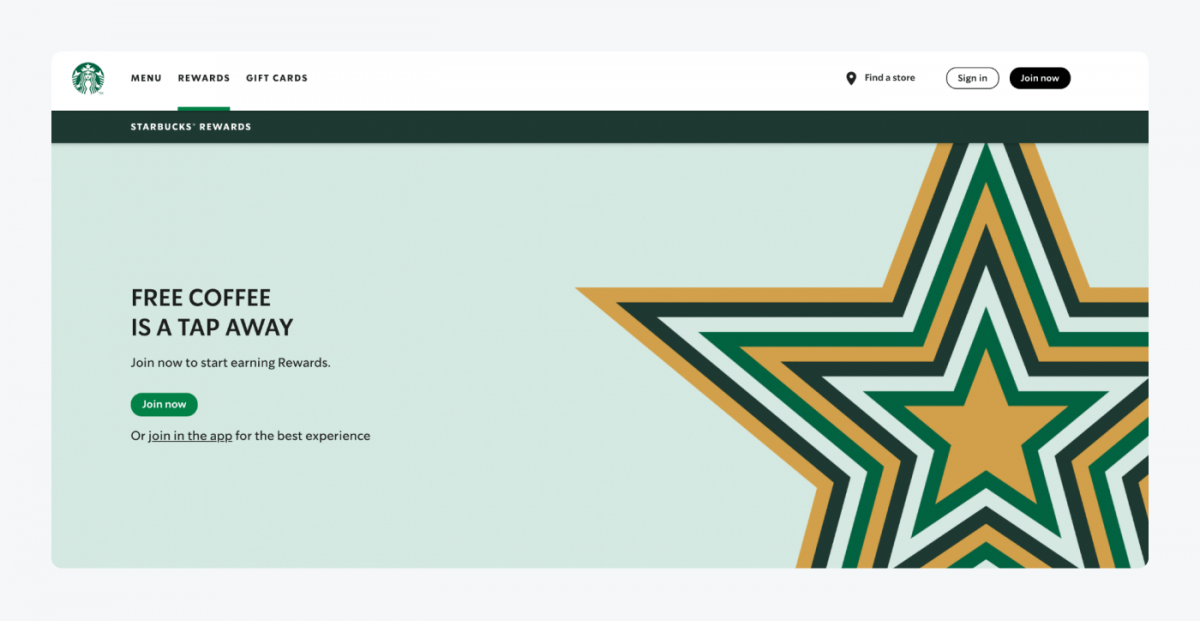
The coffee-selling giant resigned from traditional customer loyalty cards and instead, created one of the most popular customer loyalty apps on the market. Their program is a perfect example of a hybrid between a modern punch card, and collecting points system.
With Starbucks rewards, you can get up to 3 stars per dollar spent, depending on the payment method.
Members of the program can then exchange the stars for food and drinks, earn discounts and get free beverages on their birthday.
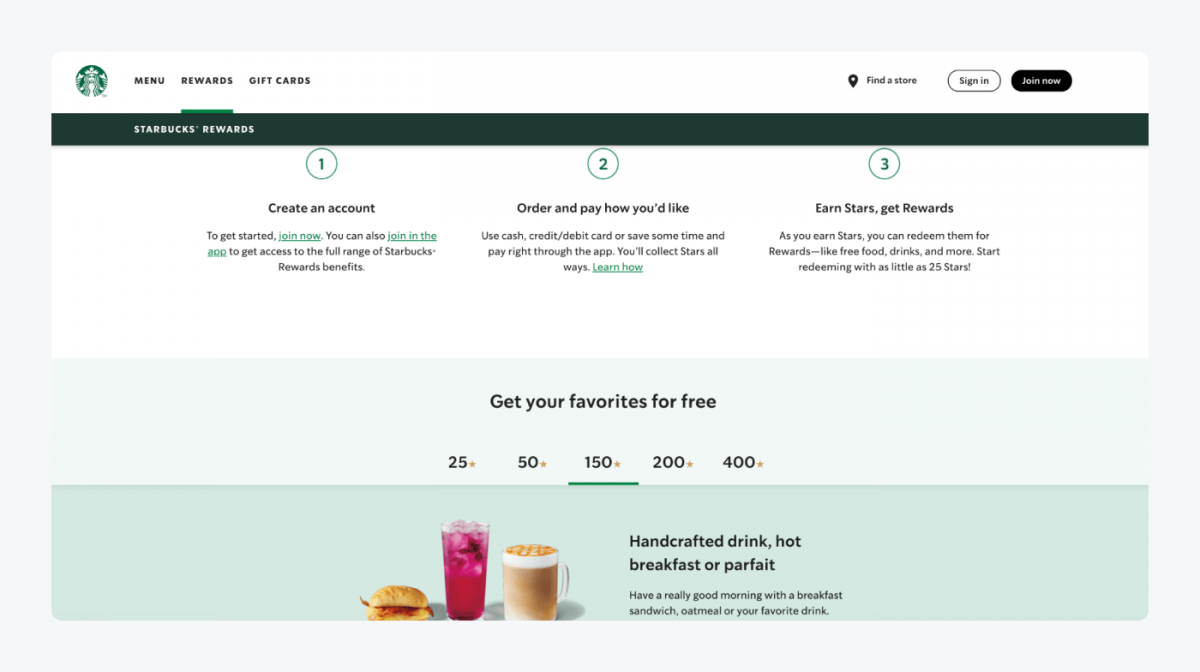
Starbucks also added an element of gamification and provided members with bonus star challenges, double-star days, and other exciting games letting them earn more stars. For coffee lovers, it’s a real treat!
Customer loyalty program ideas inspired by Starbucks
- Run a bonus point campaign from time to time. Give your customers a chance to earn double or triple points in challenges or on special days. Make it fun: encourage them to use social media and get double engagement as a bonus.
- Make it rain on their birthday. Everybody wants to feel special—surprise your customer with a personalized note and a special discount, send them a gift or give access to an unreleased product. They will remember about it!
2. TOMS rewards
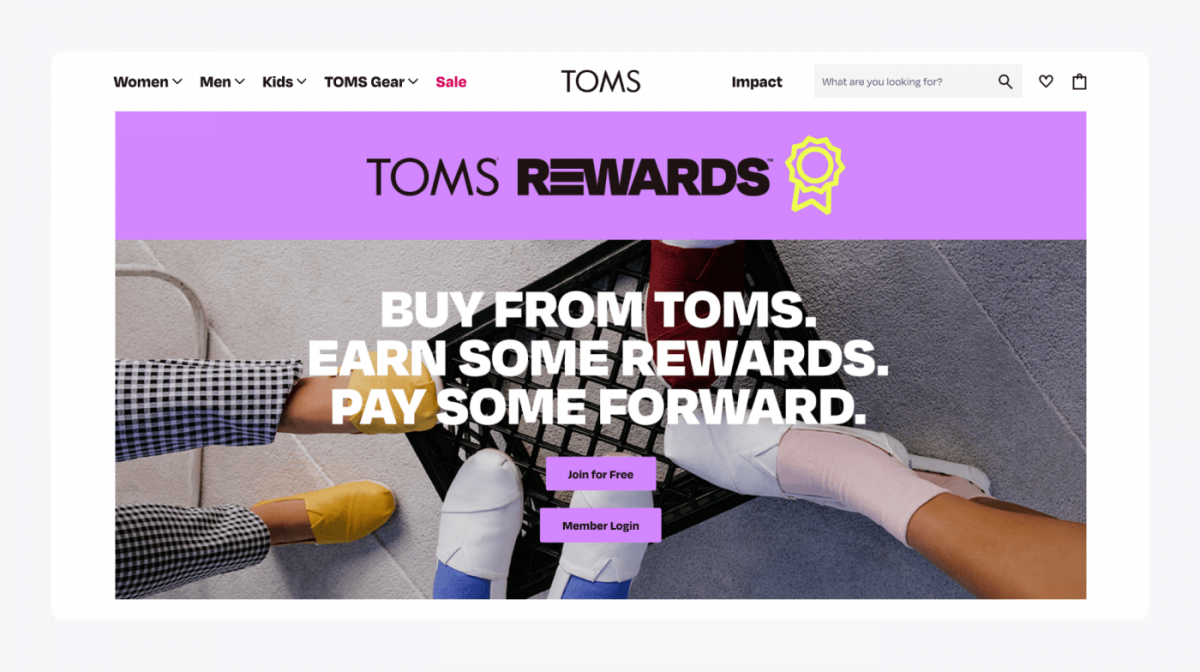
With its cause-related marketing strategy, TOMS has grown a loyal customer base that believes in the company’s product and mission. Their perks’ strategy couldn’t be underwhelming—and that’s why TOMS has one of the most effective retail customer loyalty programs. Each customer earns points that allow them to get access to exclusive offers, early access to new products, and most importantly, the possibility to pass the points to one of their charity partners.
Members of the program can earn points not only by shopping. They can also do it by:
- Upgrading their profile
- Sharing posts on social media
- Joining their email newsletter
More points mean more benefits, which makes it a perfect example of a hybrid between tier-based and point-based systems.
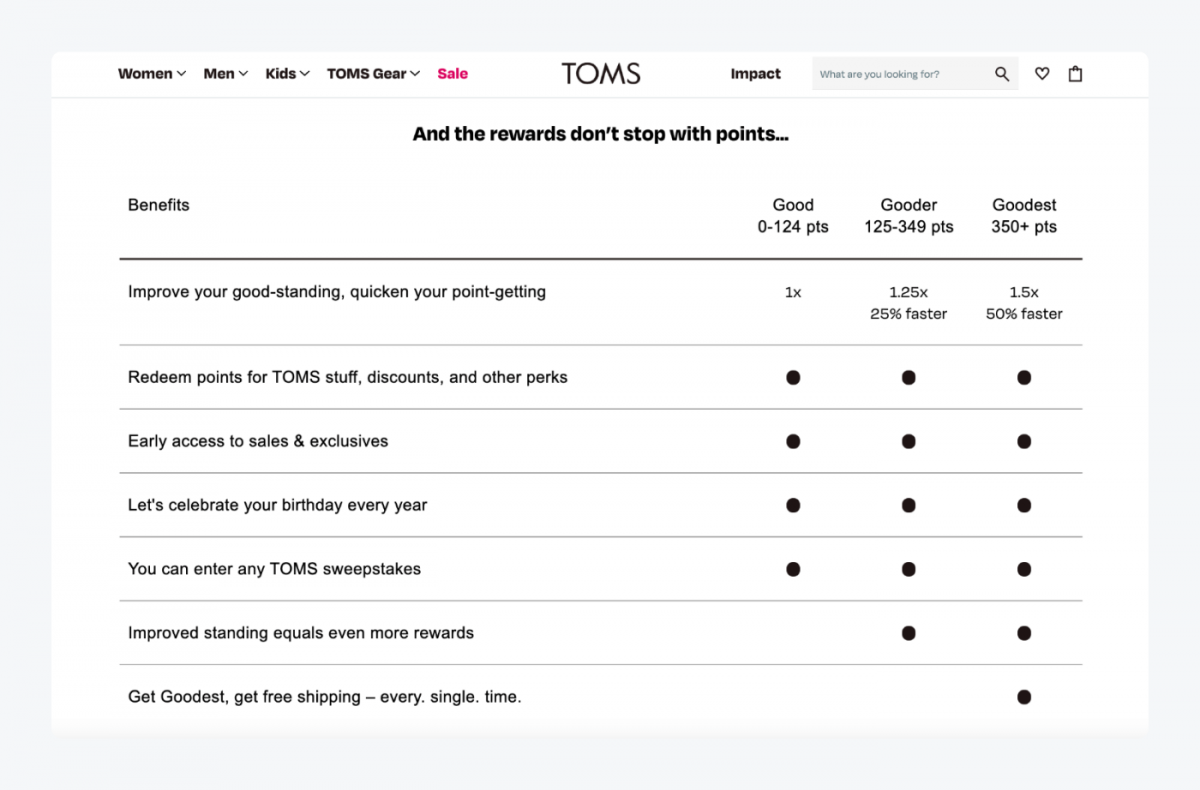
Customer loyalty program ideas inspired by TOMS
- Support their beliefs. Enable your customers to contribute to their cause. Like TOMS, you can offer to exchange the points for money for the charity of choice.
- Provide free shipping for all members. Everybody wants to avoid shipping costs! By providing free shipping, your loyal customers will buy from you more often.
3. Morphe rewards
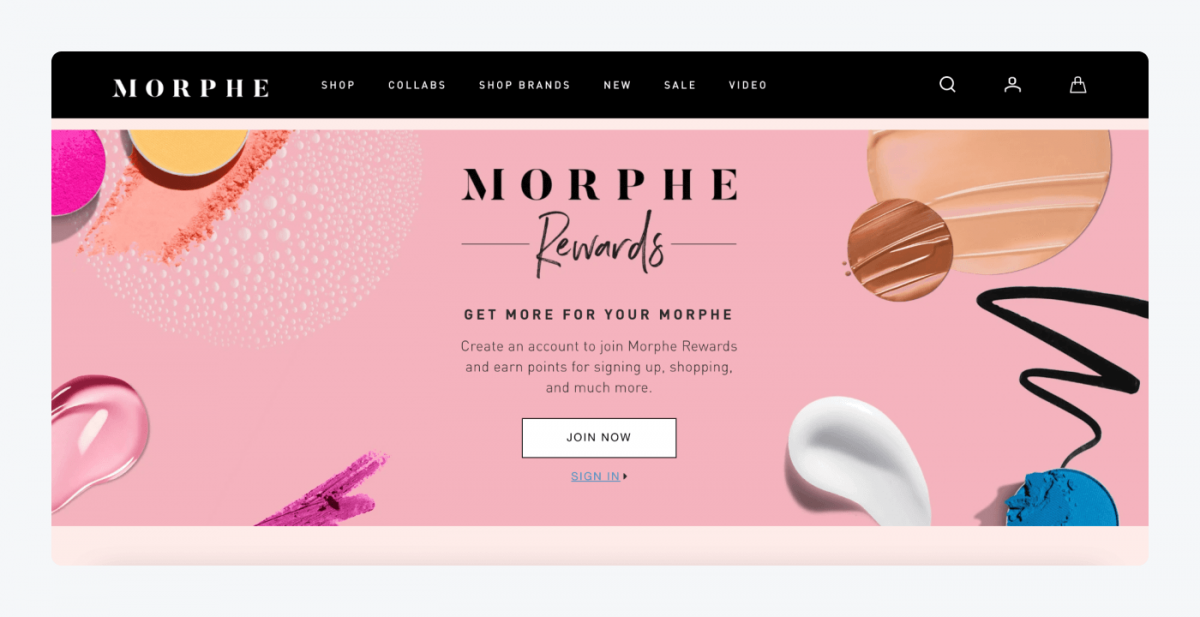
Similar to TOMS, the beauty industry giant has a hybrid program thanks to which you can collect points when you shop and enjoy more benefits as your points grow. Each dollar earns you 1, 1.25, or 1.5 points based on your tier (Rising star, Hotshot, and Icon tiers, respectively).
Members can earn points by:
- Registering an account
- Tagging the company on IG
- Subscribing to a newsletter
- Referring a friend (this action earns them a whopping 100 points!)
Points can be exchanged for discounts, but it doesn’t end there. Each member gets an exclusive birthday offer, anniversary gift, and those among the highest tiers get early access to sales and special surprises. Sounds like a perfect deal for all make-up geeks out there.
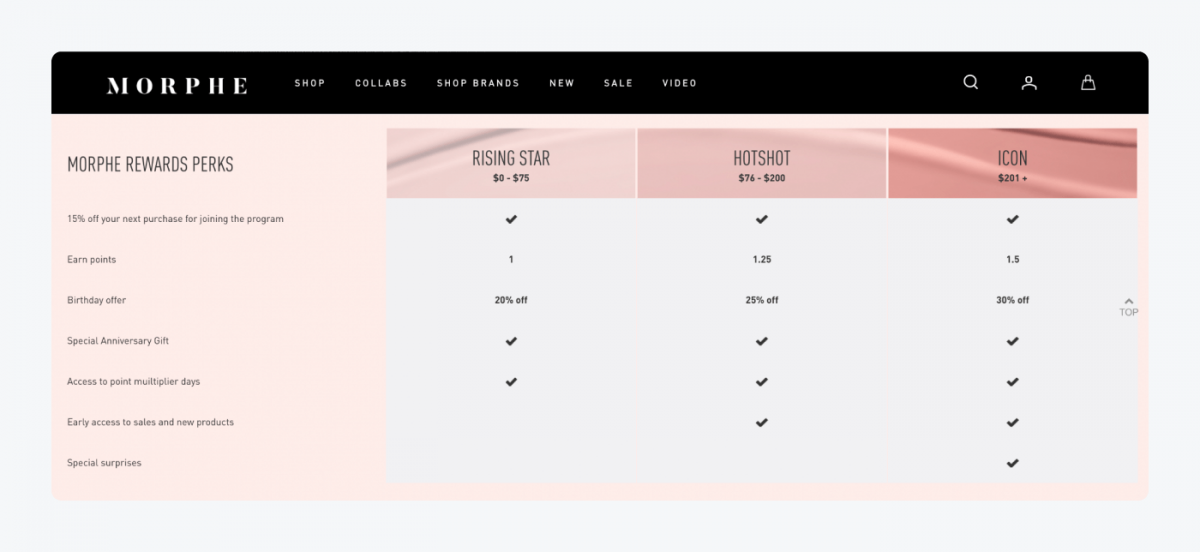
Customer loyalty program ideas inspired by Morphe
- Offer exclusive bonuses for your top customers. If you run a tier program, provide your top customers with generous giveaways, special surprises, and free goodies. Give them points for sharing reviews on social media. And watch your hype grow!
- Enable your top-tier customers to earn points faster. This means that they can enjoy more perks as they purchase from you. Make sure this doesn’t go unnoticed by other customers.
4. Amazon Prime membership
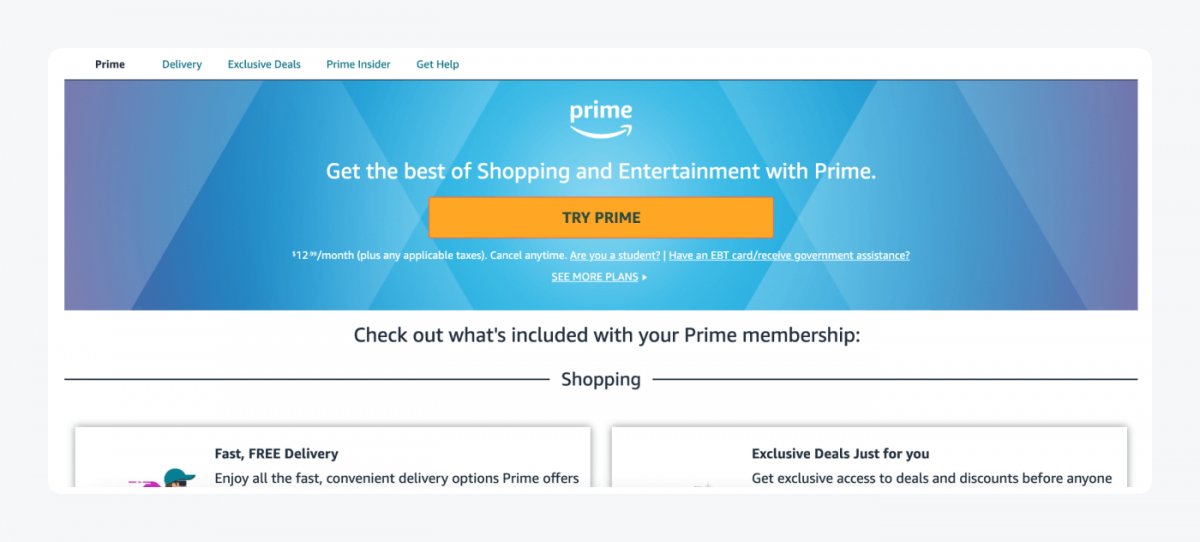
Amazon Prime membership is a perfect example of a paid program, where the customer pays $12.99 per month or $113 a year and enjoys a long list of benefits.
The program includes:
- free shipping on all eligible offers
- exclusive deals
- unlimited access to Amazon Video, Amazon Music, and games
- Up to 5% of their Wholefoods shopping value back, once they use Visa Amazon Card.
All the above creates a reliable shopping experience for its members, which seems to be confirmed by the numbers. It’s reported that up to 70% of consumers who subscribed to the program for a year or more were satisfied with their experience.
Moreover, two-thirds or more spend more on Amazon now than when they first signed up, according to an RBC Capital Markets survey.
Customer loyalty program ideas inspired by Amazon Prime
- Partner with a company that offers services or products targeted at your customer. Do you sell luxury hair products? Partner with your local hairdresser and offer co-branded deals. Do you own a shop with products for animals? Join your forces with a local vet clinic.
- Provide multiproduct/multiservice perk. When you offer more than one type of product, try to diversify your perks, presenting your prospective members with a variety of reasons to join your program.
5. Tesla customer loyalty program
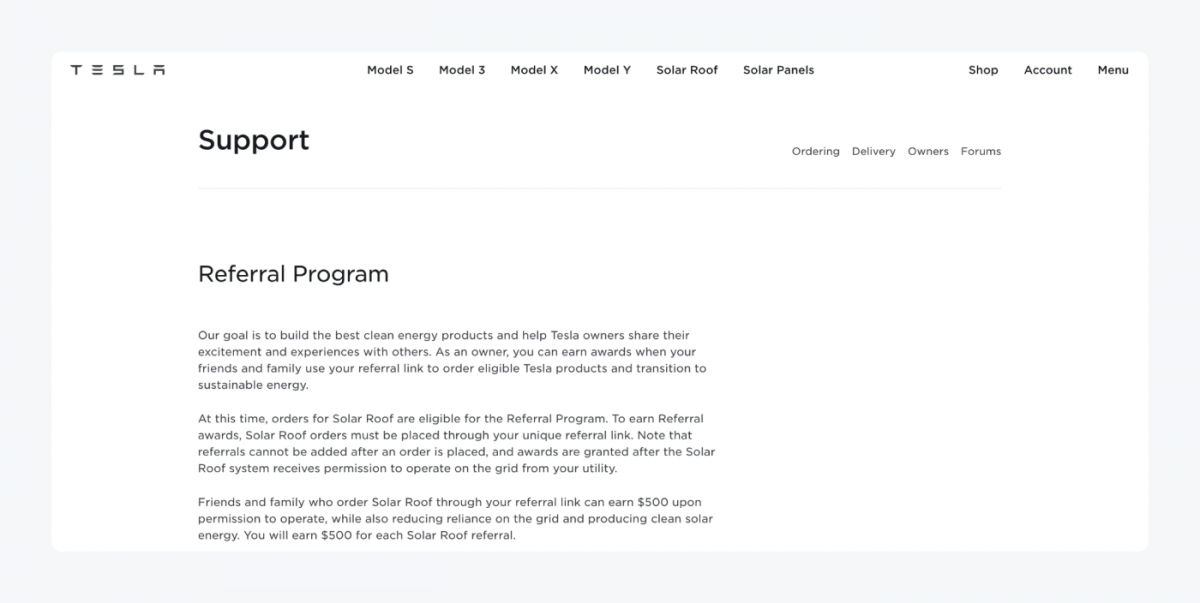
Wait—do they even have a loyalty program? Well, yes, it’s just less obvious than your usual programs of this type. Because Tesla provides an extraordinary customer experience around purchasing their cars, the company’s customers quickly turn into its best brand ambassadors.
Let me explain—each customer is automatically enrolled into the referral program after they made a purchase. They are not obliged to refer friends or family, but they receive a unique referral link. Once it is used for the new purchase, both referring and referred parties get up to $500 (as I’m writing this text, the main referral product is the solar roof panels).
It’s difficult to assign Tesla, Inc. to any of the six categories of loyalty programs we mentioned above. That’s because they are a part of a new type of loyalty program. You can read more about it in the article about informal loyalty and Tesla.
Customer loyalty program ideas inspired by Tesla
- Offer first-time purchase discounts. Like Tesla, turn your new customers into loyal ones right from the start. Give them a discount code once they complete a purchase—it’s the simplest, yet the most effective way to start off your loyalty program!
- Offer generous rewards for referrals. Offer massive discounts or giveaways not only to the referring, but also to the referred party.
Measuring customer loyalty
You know how to build customer loyalty, but you also need to know how to improve customer loyalty management. To do it right, you need to know how to look at customer data. Let’s have a look at the most important metrics and see why they are crucial for your business development.
1. NPS survey®
Net Promoter Score (NPS) is the most popular customer loyalty survey. It consists of a single question that asks the customers how likely they are to recommend your product, service, or company to others. Respondents use a scale from 1 to 10, generating a score ranging from -100 to 100. Based on the score, you can group your customers into three categories:
- Promoters: Customers who gave you the highest ratings of 9 or 10. They are loyal and most likely promote your company among their friends and family.
- Passives: Customers who gave you a rating of 7 or 8. Passives are the neutral group among your customers. They won’t spread negative comments, but won’t promote your brand on social media either.
- Detractors: Customers who gave you a rating of 6 or lower, stating that they are not happy with their experience. They won’t buy from you again and will discourage others from buying from you, too.
To calculate your NPS, subtract the percentage of your detractors from the percentage of your promoters:
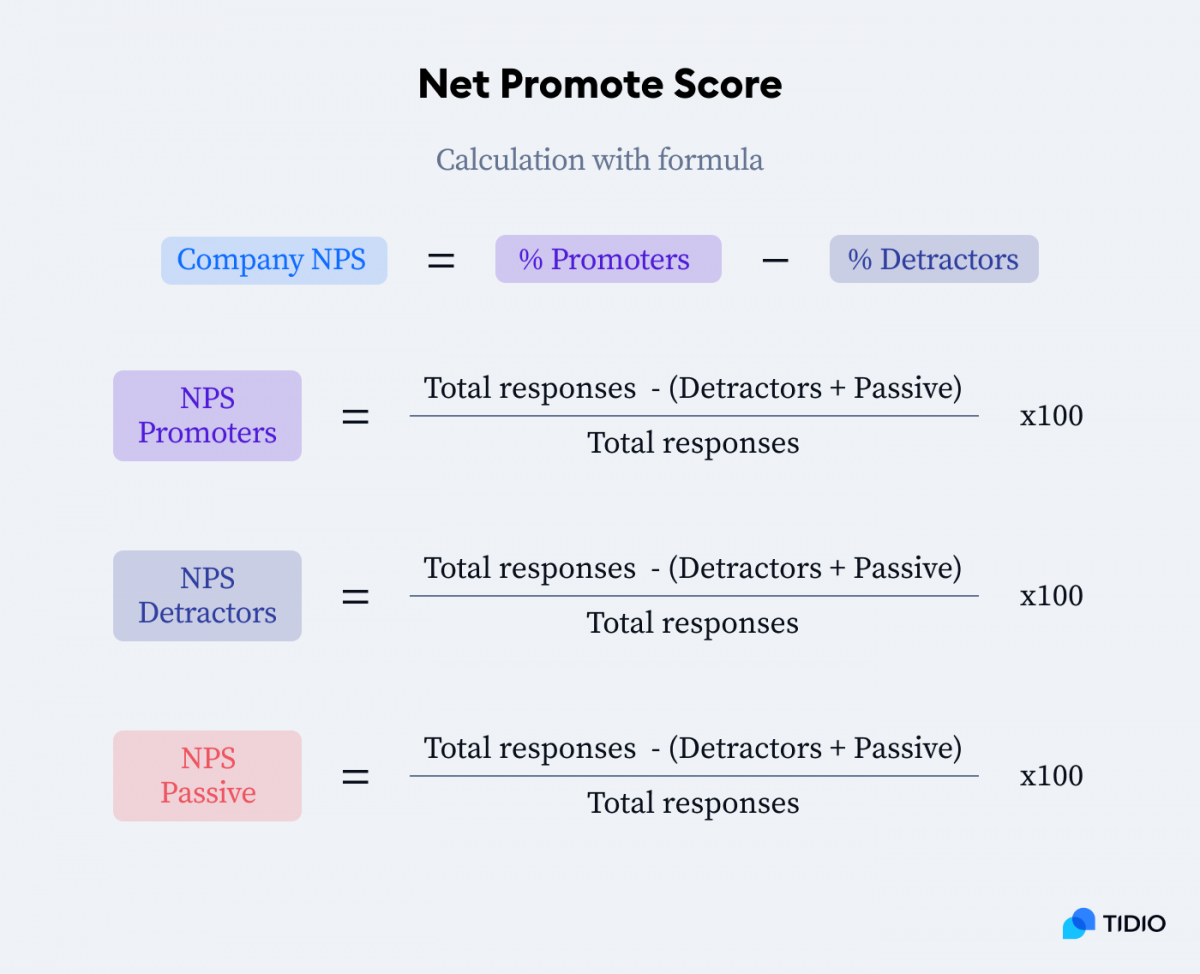
2. Customer lifetime value (CLV)
CLV indicates the total revenue attributed to the entire relationship with a customer. This metric helps to identify valuable customers. Additionally, CLV helps you to estimate the cost of acquiring new customers, which makes it especially useful when planning a new marketing strategy.
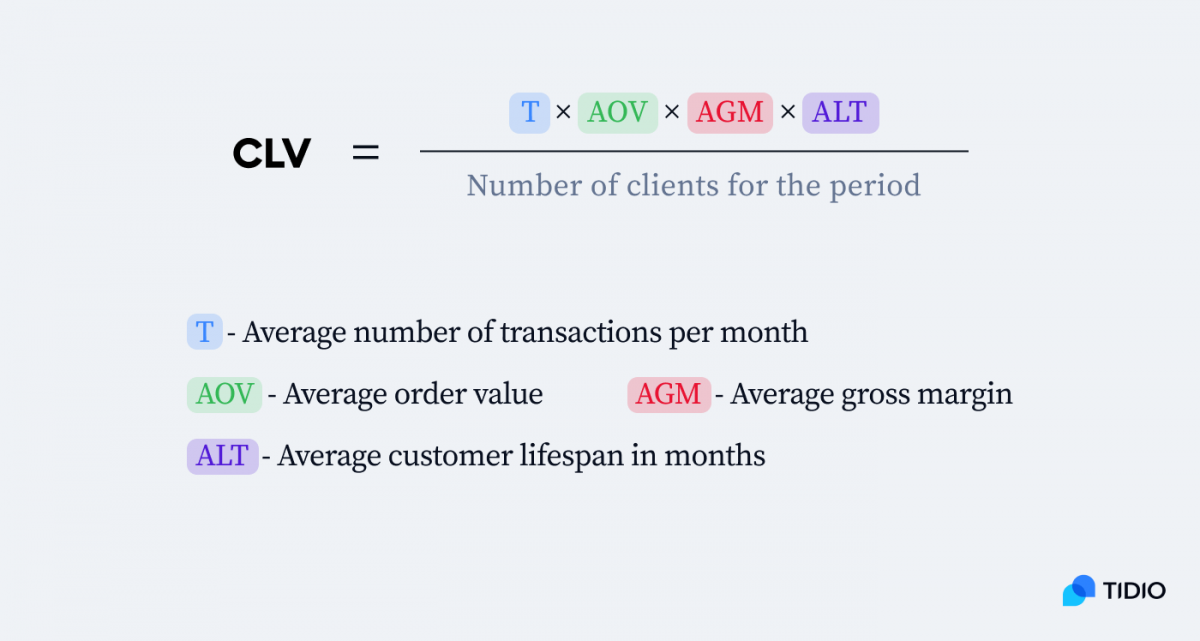
3. Customer loyalty index
CLI measures multiple factors at the same time: NPS, upselling, and repurchasing.
CLI survey consists of three questions:
- How likely are you to recommend us to your friends and family?
- How likely are you to buy from us again in the future?
- How likely are you to try our other products?
The customer responds to each question on a scale from 1 to 6, where 1 corresponds to “Definitely Yes”, and 6 corresponds to “Definitely No”.
The CLI for a customer is the average score of their three responses, translating to the following scores:
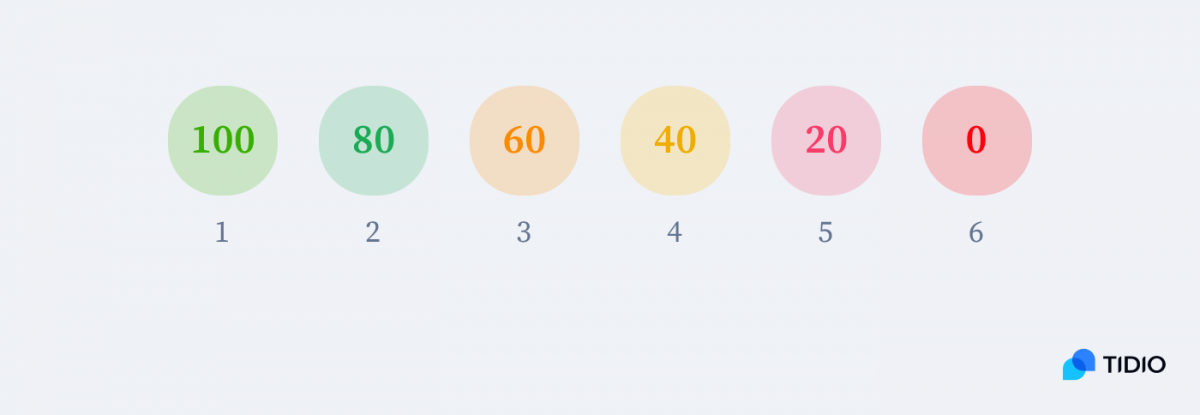
It’s a good practice to measure CLI regularly in order to keep track of loyalty and observe trend patterns.
4. Loyal customer rate
Loyal customer rate enables you to identify your most loyal customers, so you can put them into top-tier priority when it comes to VIP programs, unreleased products, or other exclusive incentives.
To measure your loyal customer rate, take the number of customers who’ve purchased more than four times in a year and divide it by the number of unique customers in the same period.
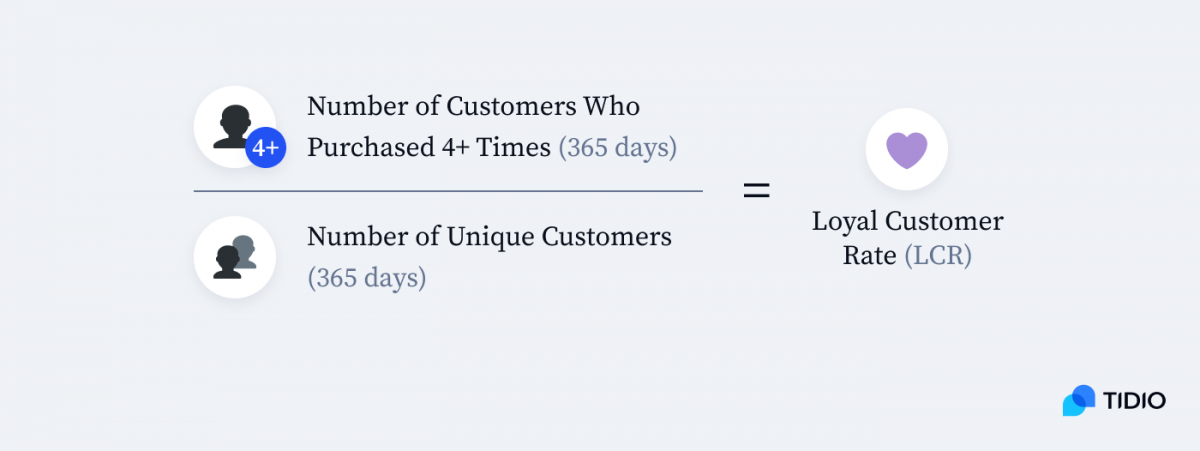
5. Purchase frequency
This metric shows how often an average customer makes a purchase, which allows you to assess the customer loyalty potential.
To measure average purchase frequency, divide the total number of unique orders in a given time period by the number of unique customers.
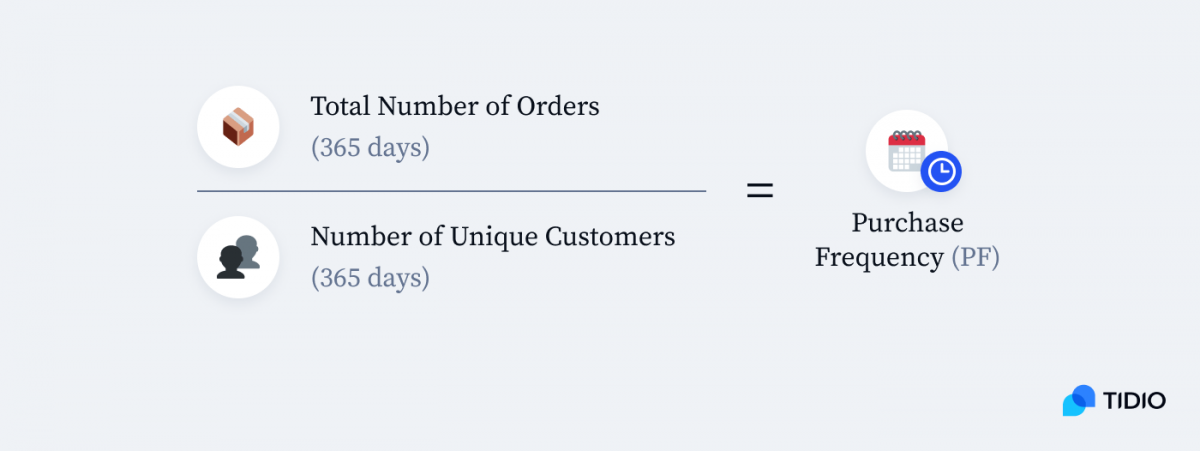
Useful customer loyalty program software
Good news—you don’t need to use fancy customer loyalty software to measure the metrics and assess your effectiveness. Let’s have a look at the most useful tools that will help you interpret customer loyalty analytics.
- Google Analytics. An absolute must when it comes to the measurement of customer loyalty programs for small businesses. A well-set-up account will measure conversions, show average order value and returning users, as well as display a purchase path.
- OpenLoyalty. This software provides you with a mechanism to easily build personalized customer loyalty programs or use one of the 50+ templates (points, referrals, coupons, tiers).
- Hotjar. Thanks to visual heatmaps, you can see how your loyal customers behave: for example, if they purchase a product using the discount you sent them, or do they bounce quickly, showing no interest.
- MyCreativeShop. If you run a small brick-and-mortar business and prefer to stick to traditional loyalty programs, you can generate your own loyalty card using free customer loyalty punch cards templates to start in no time.
- CandyBar. If you want to introduce digital punch cards among your clientele, this software allows you to do it easily.
- Tidio chatbots. Tidio enables you to use AI-powered chatbots that automatically reward customers that regularly visit or interact with your website, give discounts on special occasions, and engage your customers on autopilot.
Key takeaway
Now you should know everything about building customer loyalty and have an idea of how to create a customer loyalty program on your own.
Let’s recap the most important info:
- Customer loyalty is the willingness of your customers to repeatedly do business with you. It’s crucial for your business development because it reduces costs, increases revenue, and creates ambassadors for your brand.
- To build customer loyalty, you need to focus on providing not only a great product but also extraordinary customer experience and customer service.
- Many go-to brands offer customer loyalty programs. You can analyze what they offer and create your own.
- Measuring customer loyalty is essential because it lets you monitor progress in delighting your customers.
- While Google Analytics and instant communication tools are efficient enough to track and measure your efforts, you can use visual analytics or build your own program with dedicated software.
Do you offer a customer loyalty program? Or maybe you are thinking about establishing one? Start delighting your customers with instant answers and personalized messages with the help of Tidio chatbots.
And if you need any help in setting them up or customizing them, don’t hesitate to reach out— we will gladly help!

